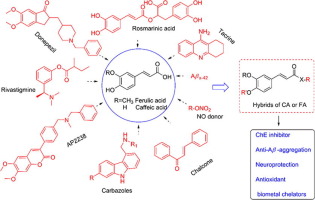Bioorganic & Medicinal Chemistry ( IF 3.3 ) Pub Date : 2017-12-26 , DOI: 10.1016/j.bmc.2017.12.042 Xiao Zhang , Xixin He , Qiuhe Chen , Junfeng Lu , Simona Rapposelli , Rongbiao Pi

|
Alzheimer’s disease (AD), a complex chronic progressive central nervous system degenerative disease and a public health problem of the world, often characters cognitive dysfunction accompaning aggression and depression, and may lead to death. More attentions should be paid on it because there is no modified strategy against AD till now. AD is featured with the loss of cholinergic neurons, the amyloid-beta peptide (Aβ) plaques and the neurofibrillary tangles and several hypotheses were established to explain the pathogenesis of AD. Hydroxycinnamic acids, including caffeic acid (CA) and ferulic acid (FA) are widely distributed in natural plants and fruits. CA and FA exert various pharmacological activities, including anti-inflammatory, antioxidant, neuroprotection, anti-amyloid aggregation and so on. All these pharmacological activities are associated with the treatment of AD. Here we summarized the pharmacological activities of CA and FA, and their hybrids as multi-target-directed ligands (MTDLs) against AD. The future application of CA and FA was also discussed, hoping to provide beneficial information for the development of CA- and FA-based MTDLs against AD.
中文翻译:

羟基肉桂酸杂化物作为对抗阿尔茨海默氏病的多靶标配体的研究进展
阿尔茨海默氏病(AD)是一种复杂的慢性进行性中枢神经系统退行性疾病,是世界范围内的公共卫生问题,通常特征是伴随着攻击和抑郁的认知功能障碍,并可能导致死亡。由于目前尚无针对AD的修改策略,因此应引起更多关注。AD的特征与胆碱能神经元的损失,淀粉样蛋白β肽(A β)斑块和神经原纤维缠结以及一些假设被建立以解释AD的发病机理。包括咖啡酸(CA)和阿魏酸(FA)在内的羟基肉桂酸广泛分布于天然植物和水果中。CA和FA发挥各种药理活性,包括抗炎,抗氧化剂,神经保护,抗淀粉样蛋白聚集等。所有这些药理活性与AD的治疗有关。在这里,我们总结了CA和FA及其杂种作为抗AD的多靶标配体(MTDLs)的药理活性。还讨论了CA和FA的未来应用,以期为开发基于AD的基于CA和FA的MTDL提供有益的信息。









































 京公网安备 11010802027423号
京公网安备 11010802027423号